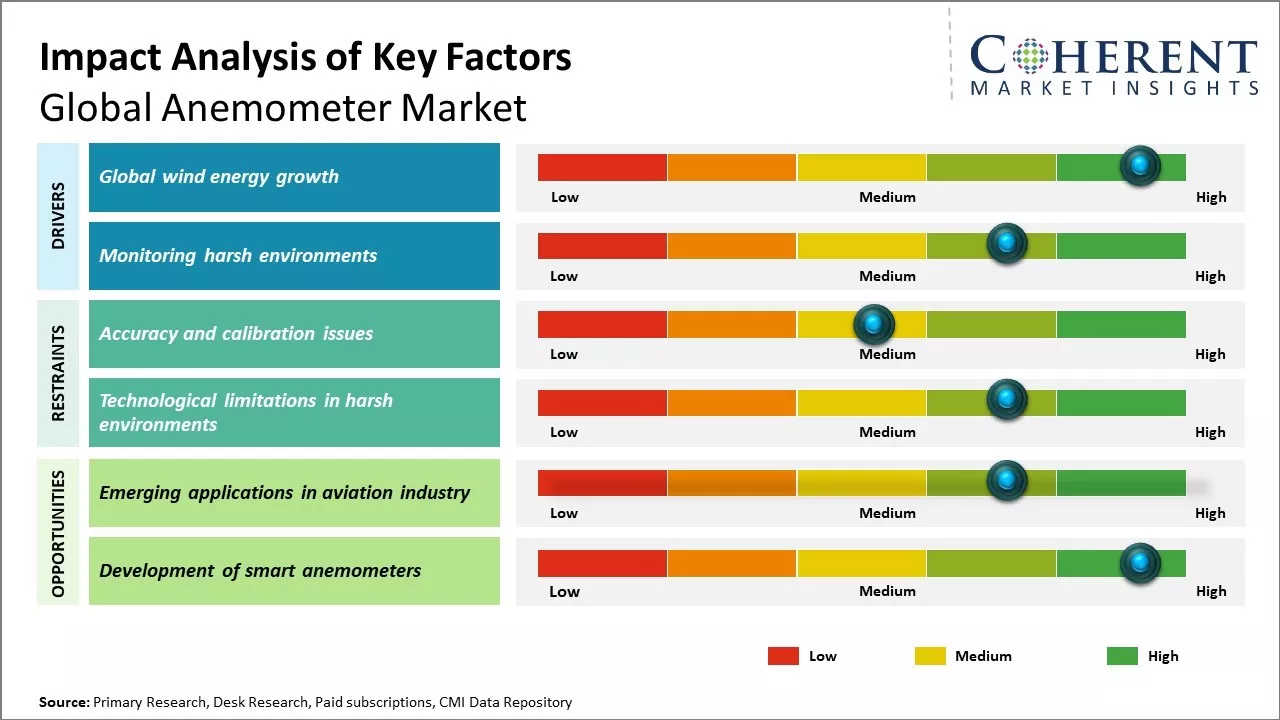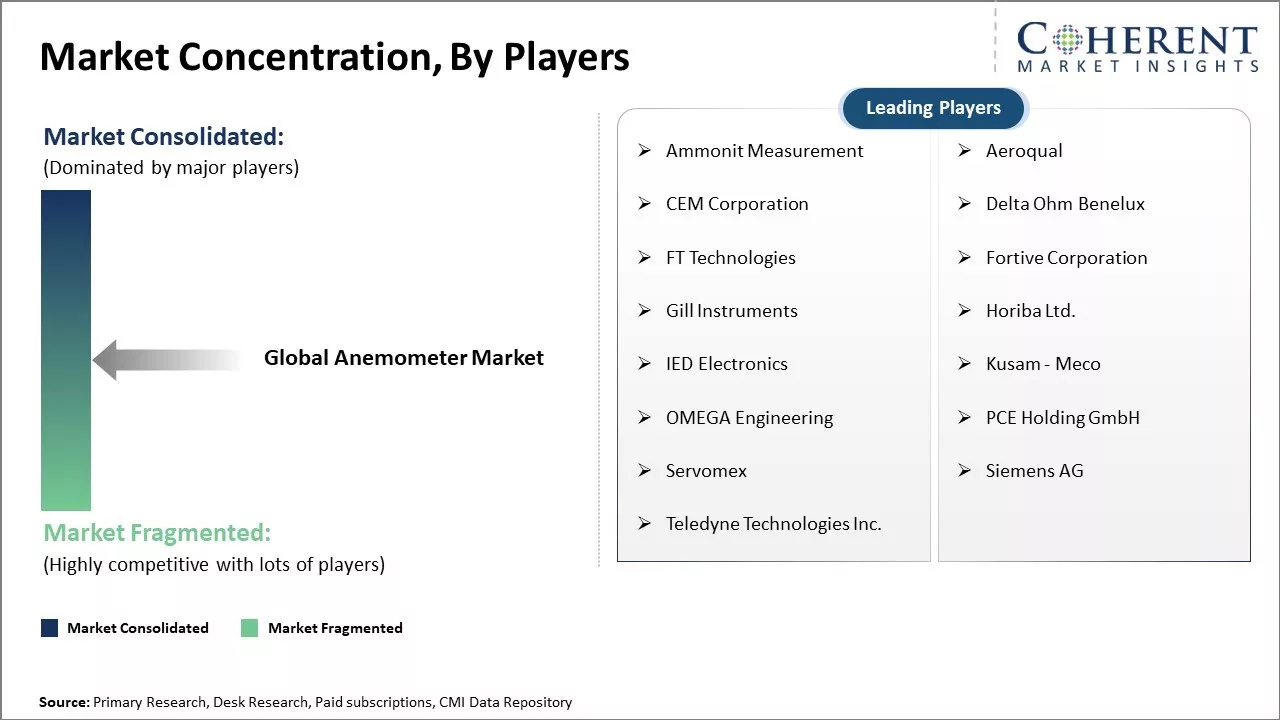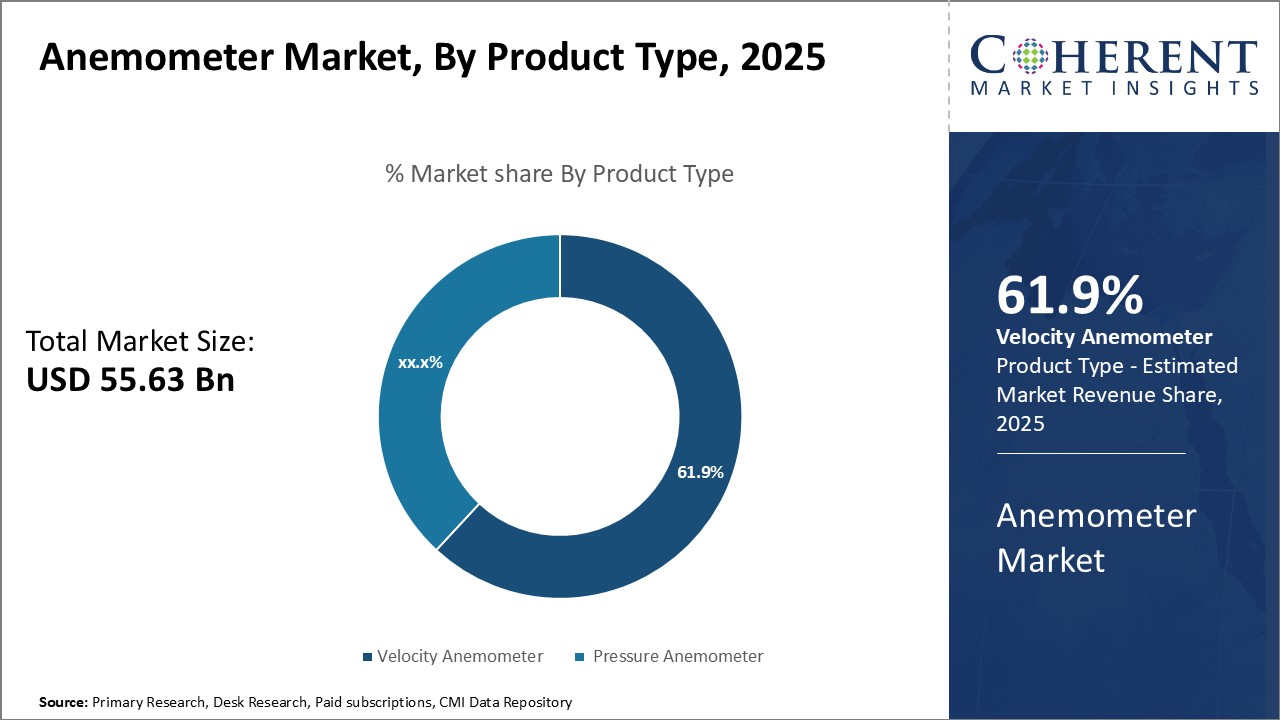The global anemometer market is estimated to be valued at US$ 55.63 Bn in 2025 and is expected to reach US$ 88.80 Bn by 2032, exhibiting a compound annual growth rate (CAGR) of 6.9% from 2025 to 2032. The market is primarily driven by the increasing demand for anemometers from the healthcare, electronics, precision manufacturing, and automotive industries. Precise measurement of airflow is important in terms of quality assurance, air circulation control, and prevention of contamination in these industries.

Discover market dynamics shaping the industry: Download Free Sample
The global anemometer market is expected to witness significant growth during the forecast period. The growing emphasis on workplace safety and increasing investments in wind energy projects are some of the major factors propelling the demand for anemometers. In addition, technological advancements leading to the introduction of smart and portable anemometers equipped with wireless connectivity and intuitive interfaces are expanding the potential areas of anemometer usage.
Global wind energy growth
The use of wind energy as a renewable source of power has been growing rapidly across the world in recent years. Many countries are promoting the adoption of wind turbines to reduce dependence on fossil fuels and lower carbon emissions from the energy sector. Favorable government policies in the form of tax credits and incentives for setting up wind farms are encouraging heavy investments by energy companies. International organizations are also pushing nations to ramp up clean energy generation to meet climate targets.
This rise in the deployment of wind power infrastructure is directly fueling the demand for anemometers. Wind farms require accurate wind speed and direction data from the site before commissioning turbines. Meteorological towers equipped with multiple anemometer sensors are installed to measure the wind resource over months. The wind profiles obtained help turbine manufacturers and farm developers in selecting the most suitable turbine models. Even after establishing the wind farm, anemometers remain essential for long term wind monitoring. Their data aids in the installation of additional turbines to maximize energy yields. It also allows the remote monitoring of turbine performance and issues detection.
At the same time, the small wind turbine market catering to residential and commercial rooftop installations has been gaining traction worldwide. The promotion of microgeneration and moves to offset high electricity bills are prompting more building owners to consider integrating small vertical axis wind turbines. Though individual power capacities may be low, the collective market is significant. Anemometers tailored for small wind applications have a role in verifying wind conditions prior to turbine selection and estimating energy outputs. The assessment of urban wind resources through sensors mounted on structures like skyscrapers can also open up new opportunities.
The continuous expansion of the global wind industry in general spurred by the climate change agenda will drive persistent demand for anemometers from both utility-scale wind farms and small wind turbine markets in the coming years. Their importance in developing new wind energy projects makes them an integral part of the overall wind power value chain with plentiful opportunities.

Get actionable strategies to beat competition: Download Free Sample
Monitoring harsh environments
Environmental monitoring in remote and difficult to access areas such as oceans, mountains, forests, and deserts requires robust sensors that can withstand extreme weather conditions over long deployments. Anemometers play a crucial role in collecting meteorological data from these harsh environments which are at the frontlines of climate change. Their ability to precisely measure wind speed, direction, and temperature even while exposed to high winds, precipitation, wide temperature variations, and salt corrosion makes them irreplaceable.
Key Takeaways from Analyst:
The global anemometer market is poised to grow steadily driven by increasing applications in industries such as wind energy, aviation, marine, and construction. Strong demand from the wind energy sector to accurately measure wind speed and direction for optimizing wind turbine performance will boost market revenues. Additionally, growing investments in wind farms worldwide is another key factor driving the need for anemometers. On the other hand, high instrument costs may limit revenue growth to some extent.
Opportunities lie in widening the product portfolio with technologically advanced anemometers that offer better accuracy, durability, ease of use, and wireless connectivity. Manufacturer focus on product innovation to suit diversifying industrial needs would aid market expansion. The Asia Pacific region excluding Japan is expected to dominate market revenues over the forecast period. This can be attributed to rapid infrastructure development, rising energy demands, and favorable government policies supporting renewable energy adoption in countries such as China and India.
North America will remain an attractive regional market owing to a strong presence of leading industry players and big players making renewed investments in wind farm projects post economic recovery. In Europe, government initiatives to replace fossil fuel based power generation with renewables are creating sustained demand for anemometers from the wind energy sector.
Market Challenges: Accuracy and calibration issues
Accuracy and calibration issues have been one of the key restraints hampering the growth of the global anemometer market. Anemometers are instruments used to measure wind speed and are an important part of various industries like aviation, weather monitoring, wind energy, etc. However, maintaining long term accuracy and regular calibration of anemometer sensors has been a challenge.
Anemometers rely on sensor components like windcups, propellers, ultrasonic sensors, etc. to capture the kinetic energy of moving air and convert it into an electrical signal. Over prolonged usage, external environmental factors like dust, moisture, corrosion, etc. tend to degrade the sensitivity and functioning of these sensors. Even minor drifts in sensor readings can lead to inaccurate wind speed data. This is particularly critical in applications involving flight safety, weather forecasting models, and wind turbine performance optimization which rely on highly precise anemometer measurements. Furthermore, anemometer sensors may also get knocked out of calibration due to mechanical damage during transportation or installation.
Maintaining NIST traceable calibration certification is important for anemometers used in commercial and industrial applications. However, the process of recalibrating anemometer sensors periodically in a lab setup requires downtime from use and adds to operating expenses. With the abundance of low-cost anemometer models in the market, cost-effective solutions ensuring long term accuracy and minimizing calibration needs could accelerate anemometer adoption.
Market Opportunities: Emerging applications in aviation industry
The aviation industry is embracing newer technologies at a rapid pace which is opening up opportunities for anemometers used in aircrafts. Emerging applications such as extensive research on renewable energy solutions for aircrafts as well as new vertical take-off and landing (VTOL) aircraft designs are likely to drive the demand for accurate wind measurement instruments in the coming years.
Research organizations like NASA and the European Commission are heavily funding projects for developing hybrid and all-electric aircraft prototypes which rely on technologies like wind turbines and large batteries. Anemometers play a vital role in collecting wind speed data for analyzing the feasibility of these renewable setups placed on aircraft wings and horizontal stabilizers. As these advanced aircraft concepts reach production and commercialization stages post 2025, their deployment will create persistent demand for aerodynamic anemometers specialized for aviation wind tunnels and test flights.
Similarly, novel VTOL aircraft designs capable of both helicopter- and plane-like operations are being planned for urban air mobility and cargo delivery missions. Leading automotive companies like BMW and Airbus have ongoing projects on electric VTOL vehicles aimed at air taxi services for crowded city centers. Testing and certification of VTOL aircraft aeromechanics requires sophisticated anemometers to analyze complex rotor/wing performance under varying wind conditions. Technologies proven through upcoming VTOL vehicle demonstrators in 2023 reported by European Commission may set the path for mass adoption of such aircraft in future, thus supporting anemometer usage.

Discover high revenue pocket segments and roadmap to it: Download Free Sample
Insights By Product Type - Emerging Technological Advancements Drive the Growth of Velocity Anemometers
In terms of product type, velocity anemometer is expected to contribute 61.9% share of the market in 2025 owing to emerging technological advancements that have allowed them to become more affordable and accessible. While both velocity and pressure anemometers serve important roles, velocity anemometers have benefitted significantly from innovations in sensor technology that have made them smaller, more precise, and able to transmit data wirelessly in real-time. This has expanded their potential use cases across numerous industries. Additionally, improvements in digital displays now provide velocity readings that are easier for users to interpret compared to earlier analog models. Such developments have made velocity anemometers an appealing choice for diverse monitoring needs.
Insights By Technology - Proliferation of LIDAR Technology Spurs Market Growth
In terms of technology, LIDAR (Light Detection and Ranging) is expected to contribute 55.2% share of the market in 2025 due to its rising utilization across various sectors. LIDAR offers distinct advantages over traditional SODAR systems through its use of lasers instead of sound waves. This allows for more accurate wind measurement over greater distances without interference from various environmental factors. The development of solid-state lasers and miniaturized components have made LIDAR technology more cost-effective to integrate into specialized equipment and distributed sensor networks. Its versatile data applications have enabled widespread adoption in the renewable energy industry as well as for aviation weather forecasting and infrastructure inspection. Rapid technological maturation of LIDAR continues to support increased spending and deployment.
Insights By End-use Industry - Airlines Drive Demand from Aviation Industry
In terms of end-use industry, aviation is expected to contribute 35.7% share of the market in 2025 owing to stringent regulations mandating regular anemometer use by commercial airlines. Precise wind measurement is critical for flight planning and ensuring safe take-offs and landings. As passenger traffic and flights continue to rise worldwide, airlines are opting to install permanent anemometers at all airport runways and terminals to meet regulatory compliance standards. Furthermore, most major airports also utilize anemometer-integrated weather stations to forecast wind shear and gust conditions. The aviation industry remains the largest consumer segment necessitating continual equipment replacement and upgrades.

Need a Different Region or Segment? Download Free Sample
North America has established itself as the dominant region in the global anemometer market. The region is expected to account for 40.8% of the market share in 2025. With major industry players based in countries like the U.S. and Canada, the region accounts for over 30.5% of the global market share. The strong manufacturing capabilities and technological expertise have enabled companies in North America to introduce innovative products at competitive prices. Moreover, strict government regulations regarding workplace safety and environmental monitoring have propelled the anemometer demand across industries like healthcare, construction, and energy. The presence of major end-use verticals within the region has further solidified North America's leadership position.
One of the fastest growing regional markets is Asia Pacific. Central government initiatives focused on improving environmental monitoring and increasing investments in renewable energy sectors have augmented the use of anemometers in recent years. Countries like China, India, and South Korea are witnessing substantial growth owing to a rapid industrialization and a burgeoning middle-class with increased health and safety concerns. The low input and labor costs have also attracted many international manufacturers to establish production bases in Asia Pacific. This has made the region an attractive sourcing hub and greatly enhanced import and export activities. Furthermore, the growing penetration of affordable anemometers suitable for residential and commercial applications is driving market expansion.
While North America currently dominates global sales, Asia Pacific shows promise for future growth. Developing economies are progressively recognizing anemometers' importance in maintaining air quality and increasing workplace safety especially within the infrastructure, manufacturing, and utility industries. International companies seeking new growth prospects may want to consider expanding distribution networks and partnerships within emerging countries of the region.
Anemometer Market Report Coverage
| Report Coverage | Details | ||
|---|---|---|---|
| Base Year: | 2024 | Market Size in 2025: | USD 55.63 Bn |
| Historical Data for: | 2020 To 2024 | Forecast Period: | 2025 To 2032 |
| Forecast Period 2025 to 2032 CAGR: | 6.9% | 2032 Value Projection: | USD 88.80 Bn |
| Geographies covered: |
|
||
| Segments covered: |
|
||
| Companies covered: |
Ammonit Measurement, Aeroqual, CEM Corporation, Delta Ohm Benelux, FT Technologies, Fortive Corporation, Gill Instruments, Horiba Ltd., IED Electronics, Kusam - Meco, OMEGA Engineering, PCE Holding GmbH, Servomex, Siemens AG, and Teledyne Technologies Inc. |
||
| Growth Drivers: |
|
||
| Restraints & Challenges: |
|
||
Uncover macros and micros vetted on 75+ parameters: Get instant access to report
*Definition: The global anemometer market comprises manufacturing companies that produce anemometers, which are devices used to measure wind speed. Key players in this market provide various types of anemometers like cup, vane, hot-wire, and sonic anemometers. The demand for anemometers comes from sectors like meteorology, aviation, wind energy, oceanography, and indoor air quality monitoring. Factors like growth in renewable energy sector and weather monitoring activities are fueling the expansion of the global anemometer market.
Share
Share
About Author
Ankur Rai is a Research Consultant with over 5 years of experience in handling consulting and syndicated reports across diverse sectors. He manages consulting and market research projects centered on go-to-market strategy, opportunity analysis, competitive landscape, and market size estimation and forecasting. He also advises clients on identifying and targeting absolute opportunities to penetrate untapped markets.
Missing comfort of reading report in your local language? Find your preferred language :
Transform your Strategy with Exclusive Trending Reports :
Frequently Asked Questions
Joining thousands of companies around the world committed to making the Excellent Business Solutions.
View All Our Clients